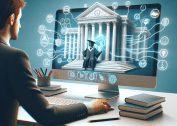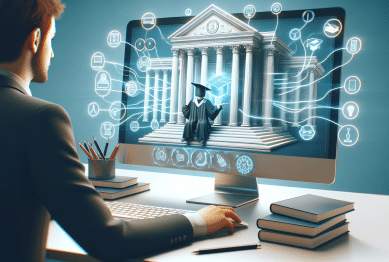Explore how remote learning is transforming education and society. This guide uncovers recent trends, flexible learning models, digital inclusivity, and the vital skills emerging from online classrooms—all to help you understand and adapt to the changing landscape of education.
The Rise of Remote Learning in Modern Education
Remote learning has rapidly expanded from a niche experiment to a mainstream method across education systems worldwide. This shift is driven by the need for flexibility and the vast opportunities that digital platforms offer. Contemporary online learning environments are powered by engaging platforms, interactive assessment tools, and dynamic content designed to support diverse learners. Students now access lectures, resources, and discussions from their homes, reshaping traditional schooling into a more adaptable format that continues to grow in popularity (Source: https://www.ed.gov/news/press-releases).
The impact of remote learning extends well beyond university students or adult learners. K-12 education systems have begun to adopt online learning modules that accommodate varying schedules and learning needs. This accessibility helps students balance studies with extracurricular responsibilities, health issues, or family commitments. The technology that underpins digital learning environments is also evolving quickly, providing seamless integration with other educational tools and apps, further enhancing the educational experience (Source: https://www.brookings.edu/research/remote-learning-during-covid-19-lessons-from-todays-crises-for-tomorrows-world/).
One standout feature of remote learning is its ability to break down geographical barriers. Students from rural or otherwise underserved regions now have unprecedented access to quality instruction and resources. Instead of being limited by local infrastructure, learners join global classrooms, benefiting from cultural exchanges and broader perspectives that fuel a richer educational experience. Such connectivity also supports collaborative projects and interactions with educators worldwide, further advancing the goals of modern society (Source: https://www.unesco.org/en/remote-learning).
Flexible Learning Models Supporting Diverse Needs
One of the greatest strengths of remote learning is flexibility. With asynchronous options, learners can progress at their own pace, revisiting complex concepts or jumping ahead where confident. Live-streamed sessions and chats allow for real-time engagement, creating a sense of classroom community even when miles apart. Students with unique learning schedules, such as working adults or caregivers, especially appreciate being able to tailor educational progress around life’s demands (Source: https://www.nasbonline.org/index.php/remote-learning-best-practices).
These adaptive learning models help reduce barriers to access in education, promoting equity for learners with disabilities or chronic health conditions. Enhanced features like screen readers, real-time captions, and flexible deadlines provide opportunities to succeed for wider audiences. Technology fosters personalized education plans that meet each individual’s needs, increasing both retention and satisfaction for all learners involved.
Parents and educators also benefit from flexible models. Families are given space to be more involved in a student’s daily academic progress and can monitor engagement through educator dashboards or parent portals. This shift encourages constructive collaboration among teachers, parents, and students, ultimately creating a support network to bolster each learner’s success, and contributing to improved educational outcomes for society as a whole.
Digital Inclusivity and Bridging the Education Gap
While remote education offers powerful new opportunities, the digital divide remains a challenge. Access to reliable internet and digital devices is not universal, particularly in remote or low-income communities. Educational leaders and policymakers have responded with programs targeting internet accessibility, device distribution, and basic digital literacy workshops (Source: https://digitalpromise.org/2020/05/12/bringing-the-promises-of-online-learning-to-under-connected-students/). Their efforts are essential for ensuring that every learner can tap into the opportunities remote learning provides.
Nonprofit organizations and public-private partnerships have played a pivotal role in digital inclusion. Creative initiatives include lending libraries for laptops and tablets, funding for hot spots, and community centers offering training for both students and parents. As digital awareness spreads, gaps in participation and achievement begin to narrow. Making sure all learners—regardless of background—can thrive in digital classrooms lifts entire communities and drives workforce skills development for the future.
Digital inclusivity strategies not only improve educational equity but also promote broader societal advancement. The ability to participate in online courses fosters critical thinking, digital citizenship, and problem-solving skills needed in the evolving job market. Community-wide gains ripple outward, strengthening regional economies and preparing societies to meet shifting challenges with resilience and creativity (https://digitalpromise.org/2020/05/12/bringing-the-promises-of-online-learning-to-under-connected-students/).
Emerging Skills and Opportunities From Online Classrooms
Remote learning environments cultivate valuable skills that align closely with evolving workforce demands. Navigating digital platforms, collaborating in virtual teams, and managing self-directed projects are now fundamental aptitudes. Learners gain experience in time management, digital communication, and online research—skills that directly translate into career readiness across many industries (Source: https://ecampusontario.pressbooks.pub/remotelearning/chapter/skills-for-remote-learning/).
Opportunities for lifelong learning are also expanding as a direct result of digital education. Working professionals can access micro-credentials or upskilling courses tailored to emerging technology and industry changes. This democratization of learning means that anyone with an internet connection can upgrade their skill set or explore entirely new fields, supporting personal achievement and adaptability in rapidly shifting environments.
The collaborative ethos of online classrooms exposes participants to new perspectives and cross-cultural dialogues on a regular basis. Learners not only master facts and theories but also practice the kind of communication, empathy, and teamwork that global workplaces increasingly demand. These soft skills, developed alongside technical competence, are now as crucial as academic achievements for success in the digital age.
Challenges and Opportunities in Remote Learning Adoption
Despite the progress, remote learning poses challenges for educators, students, and parents. Maintaining engagement through screens can be difficult, requiring new teaching methods and thoughtful class design. Instructors need to adapt materials to be interactive and accessible, while students must foster independent study habits that motivate learning without direct supervision (Source: https://www.brookings.edu/research/remote-learning-during-covid-19-lessons-from-todays-crises-for-tomorrows-world/).
However, each challenge brings an opportunity for innovation. Gamification strategies, peer learning groups, discussion boards, and personalized learning paths are just a few creative responses emerging in digital education. Educational technology continues to evolve, with adaptive learning tools targeting individual strengths and weaknesses, further closing achievement gaps and maximizing learning potential.
Feedback mechanisms help address setbacks in remote learning. Regular check-ins between teachers and students, digital office hours, and robust analytics provide data to shape effective policy and teaching methods. As these tools advance, the remote learning experience can be refined to meet both academic and emotional needs—reflecting a truly holistic approach to education for the future.
The Broader Societal Impact of Digital Education
The influence of remote learning ripples far beyond classrooms. Families collaborate more closely with educators, joining forces to support student progress. Schools become learning hubs connecting homes, workplaces, and community centers in a broader ecosystem that values flexibility and lifelong growth (Source: https://www.edutopia.org/article/distance-learning-community-culture).
This interconnected approach supports community resilience. As digital literacy improves, people are better prepared to navigate not only further study but also daily tasks like banking, healthcare appointments, and civic engagement. The future of education and society is shaping up to be more inclusive, collaborative, and adaptable than ever before.
Digital education’s growing emphasis on collaboration, inclusivity, and skill-building directly shapes tomorrow’s workforce and citizenry. A society that values learning innovation is equipped to face global challenges, nurture creativity, and foster economic growth. As online learning continues to evolve, its positive impacts promise to reach even further, influencing how people live, work, and connect worldwide.
References
1. U.S. Department of Education. (n.d.). Press releases. Retrieved from https://www.ed.gov/news/press-releases
2. Brookings Institution. (n.d.). Remote learning during COVID-19: Lessons from today’s crises for tomorrow’s world. Retrieved from https://www.brookings.edu/research/remote-learning-during-covid-19-lessons-from-todays-crises-for-tomorrows-world/
3. UNESCO. (n.d.). Remote learning. Retrieved from https://www.unesco.org/en/remote-learning
4. Edutopia. (n.d.). Distance learning and community culture. Retrieved from https://www.edutopia.org/article/distance-learning-community-culture
5. Digital Promise. (2020). Bringing the promise of online learning to under-connected students. Retrieved from https://digitalpromise.org/2020/05/12/bringing-the-promises-of-online-learning-to-under-connected-students/
6. eCampusOntario. (n.d.). Skills for remote learning. Retrieved from https://ecampusontario.pressbooks.pub/remotelearning/chapter/skills-for-remote-learning/









